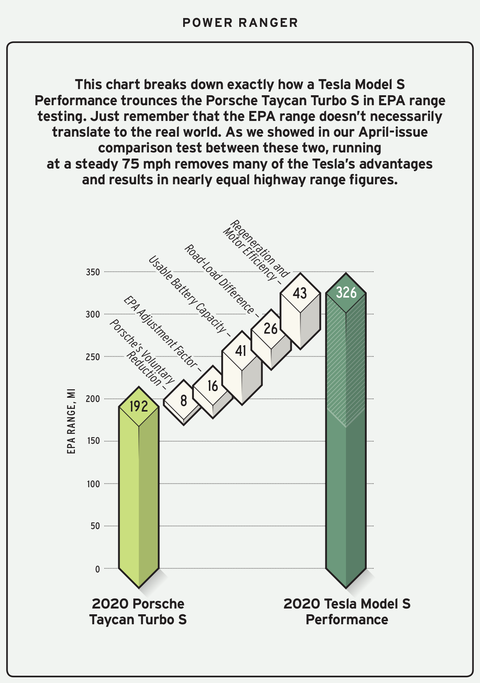or why never to trust marketing...
The Adjustment Factor
Digging into the specifics of EV range quickly uncovers a rabbit hole of dense technical documents, such as the SAE's 32-page J1634 standard that governs range and efficiency testing. Here's the summary: EVs are strapped to a dynamometer—essentially a treadmill for cars—and repeatedly run through a test regimen that ends only when the battery is depleted to the point that the vehicle can no longer maintain the required speed. This procedure uses the same EPA city cycle (20-mph average speed over 7.5 miles with 18 stops) and highway cycle (48-mph average speed, 10.3 miles) used for fuel-economy tests of all light-duty vehicles. Both cycles feature extremely gentle driving; the most aggressive acceleration would be equivalent to an 18-second 60-mph time. Between city and highway loops, the test calls for a steady speed of 55 or 65 mph to deplete the battery. The EPA knows these low-speed tests aren't representative of the real world, so every EV's window-sticker range is the product of an adjustment factor that yields a more realistic consumer-facing figure.
Based on the limited data we have, it seems that Tesla allows its cars to use more of a pack's capacity than other manufacturers do. We suspect that's partially because the company puts some of the responsibility on the driver to choose how high to charge the battery, noting that anything above a 90 percent charge should be reserved only for trips, not everyday use.

full article here : https://www.caranddriver.com/featur...-factor-tesla-uses-for-big-epa-range-numbers/
The Adjustment Factor
Digging into the specifics of EV range quickly uncovers a rabbit hole of dense technical documents, such as the SAE's 32-page J1634 standard that governs range and efficiency testing. Here's the summary: EVs are strapped to a dynamometer—essentially a treadmill for cars—and repeatedly run through a test regimen that ends only when the battery is depleted to the point that the vehicle can no longer maintain the required speed. This procedure uses the same EPA city cycle (20-mph average speed over 7.5 miles with 18 stops) and highway cycle (48-mph average speed, 10.3 miles) used for fuel-economy tests of all light-duty vehicles. Both cycles feature extremely gentle driving; the most aggressive acceleration would be equivalent to an 18-second 60-mph time. Between city and highway loops, the test calls for a steady speed of 55 or 65 mph to deplete the battery. The EPA knows these low-speed tests aren't representative of the real world, so every EV's window-sticker range is the product of an adjustment factor that yields a more realistic consumer-facing figure.
Based on the limited data we have, it seems that Tesla allows its cars to use more of a pack's capacity than other manufacturers do. We suspect that's partially because the company puts some of the responsibility on the driver to choose how high to charge the battery, noting that anything above a 90 percent charge should be reserved only for trips, not everyday use.

full article here : https://www.caranddriver.com/featur...-factor-tesla-uses-for-big-epa-range-numbers/
